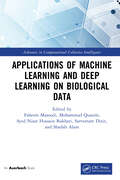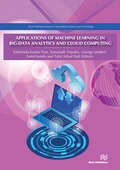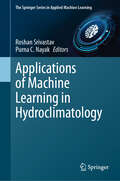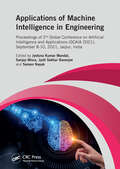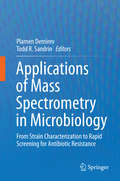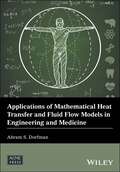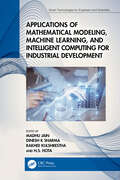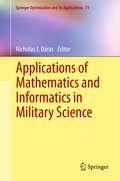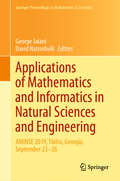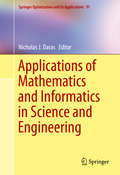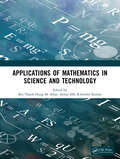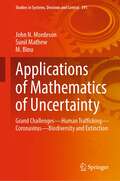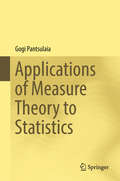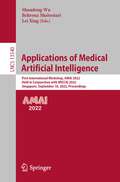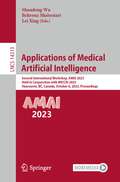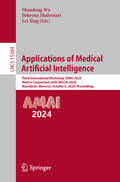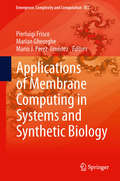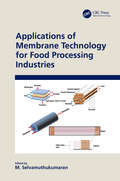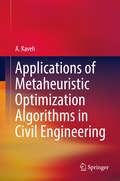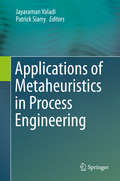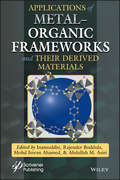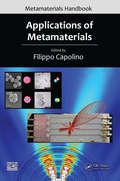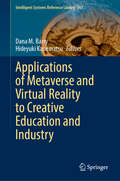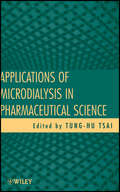- Table View
- List View
Applications of Machine Learning and Deep Learning on Biological Data (Advances in Computational Collective Intelligence)
by Faheem Masoodi Mohammad Quasim Sarvottam Dixit Shadab Alam Bukhari, Syed Nisar HussainThe automated learning of machines characterizes machine learning (ML). It focuses on making data-driven predictions using programmed algorithms. ML has several applications, including bioinformatics, which is a discipline of study and practice that deals with applying computational derivations to obtain biological data. It involves the collection, retrieval, storage, manipulation, and modeling of data for analysis or prediction made using customized software. Previously, comprehensive programming of bioinformatical algorithms was an extremely laborious task for such applications as predicting protein structures. Now, algorithms using ML and deep learning (DL) have increased the speed and efficacy of programming such algorithms. Applications of Machine Learning and Deep Learning on Biological Data is an examination of applying ML and DL to such areas as proteomics, genomics, microarrays, text mining, and systems biology. The key objective is to cover ML applications to biological science problems, focusing on problems related to bioinformatics. The book looks at cutting-edge research topics and methodologies in ML applied to the rapidly advancing discipline of bioinformatics. ML and DL applied to biological and neuroimaging data can open new frontiers for biomedical engineering, such as refining the understanding of complex diseases, including cancer and neurodegenerative and psychiatric disorders. Advances in this field could eventually lead to the development of precision medicine and automated diagnostic tools capable of tailoring medical treatments to individual lifestyles, variability, and the environment. Highlights include: Artificial Intelligence in treating and diagnosing schizophrenia An analysis of ML’s and DL’s financial effect on healthcare An XGBoost-based classification method for breast cancer classification Using ML to predict squamous diseases ML and DL applications in genomics and proteomics Applying ML and DL to biological data
Applications of Machine Learning in Big-Data Analytics and Cloud Computing
by Sumit Kundu Subhendu Kumar Pani Somanath Tripathy George Jandieri Talal Ashraf ButtCloud Computing and Big Data technologies have become the new descriptors of the digital age. The global amount of digital data has increased more than nine times in volume in just five years and by 2030 its volume may reach a staggering 65 trillion gigabytes. This explosion of data has led to opportunities and transformation in various areas such as healthcare, enterprises, industrial manufacturing and transportation. New Cloud Computing and Big Data tools endow researchers and analysts with novel techniques and opportunities to collect, manage and analyze the vast quantities of data. In Cloud and Big Data Analytics, the two areas of Swarm Intelligence and Deep Learning are a developing type of Machine Learning techniques that show enormous potential for solving complex business problems. Deep Learning enables computers to analyze large quantities of unstructured and binary data and to deduce relationships without requiring specific models or programming instructions.This book introduces the state-of-the-art trends and advances in the use of Machine Learning in Cloud and Big Data Analytics. The book will serve as a reference for Data Scientists, systems architects, developers, new researchers and graduate level students in Computer and Data science. The book will describe the concepts necessary to understand current Machine Learning issues, challenges and possible solutions as well as upcoming trends in Big Data Analytics.
Applications of Machine Learning in Hydroclimatology (The Springer Series in Applied Machine Learning)
by Roshan Srivastav Purna C. NayakApplications of Machine Learning in Hydroclimatology is a comprehensive exploration of the transformative potential of machine learning for addressing critical challenges in water resources management. The book explores how artificial intelligence can unravel the complexities of hydrological systems, providing researchers and practitioners with cutting-edge tools to model, predict, and manage these systems with greater precision and effectiveness. It thoroughly examines the modeling of hydrometeorological extremes, such as floods and droughts, which are becoming increasingly difficult to predict due to climate change. By leveraging AI-driven methods to forecast these extremes, the book offers innovative approaches that enhance predictive accuracy. It emphasizes the importance of analyzing non-stationarity and uncertainty in a rapidly evolving climate landscape, illustrating how statistical and frequency analyses can improve hydrological forecasts. Moreover, the book explores the impact of climate change on flood risks, drought occurrences, and reservoir operations, providing insights into how these phenomena affect water resource management. To provide practical solutions, the book includes case studies that showcase effective mitigation measures for water-related challenges. These examples highlight the use of machine learning techniques such as deep learning, reinforcement learning, and statistical downscaling in real-world scenarios. They demonstrate how artificial intelligence can optimize decision-making and resource management while improving our understanding of complex hydrological phenomena. By utilizing machine learning architectures tailored to hydrology, the book presents physics-guided models, data-driven techniques, and hybrid approaches that can be used to address water management issues. Ultimately, Applications of Machine Learning in Hydroclimatology empowers researchers, practitioners, and policymakers to harness machine learning for sustainable water management. It bridges the gap between advanced AI technologies and hydrological science, offering innovative solutions to tackle today's most pressing challenges in water resources.
Applications of Machine intelligence in Engineering: Proceedings of 2nd Global Conference on Artificial Intelligence and Applications (GCAIA, 2021), September 8-10, 2021, Jaipur, India
by Jyotsna Kumar MandalThe Global Conference on Artificial Intelligence and Applications (GCAIA 2021) provides a prominent venue for researchers, engineers, entrepreneurs, and scholar students to share their research ideas in the area of AI. Academic researchers would reveal the results and conclusions of laboratory based investigations via the GCAIA 21 platform, which bridges the gap between academia, industry, and government ethics. The GCAIA 21 platform will also bring together regional and worldwide issues to explore current advancements in contemporary Computation Intelligence. This Conference Proceedings volume contains the written versions of most of the contributions presented during the conference of GCAIA 2021. The conference has provided an excellent chance for researchers from diverse locations to present and debate their work in the field of artificial intelligence and its applications. It includes a selection of 62 papers. All accepted papers were subjected to strict peer-review by 2–4 expert referees. The papers have been selected for this volume because of their quality and their relevance to the theme of the conference.
Applications of Mass Spectrometry in Microbiology: From Strain Characterization to Rapid Screening for Antibiotic Resistance
by Plamen Demirev Todd R. SandrinIn the last quarter century, advances in mass spectrometry (MS) have been at the forefront of efforts to map complex biological systems including the human metabolome, proteome, and microbiome. All of these developments have allowed MS to become a well-established molecular level technology for microorganism characterization. MS has demonstrated its considerable advantage as a rapid, accurate, and cost-effective method for microorganism identification, compared to conventional phenotypic techniques. In the last several years, applications of MS for microorganism characterization in research, clinical microbiology, counter-bioterrorism, food safety, and environmental monitoring have been documented in thousands of publications. Regulatory bodies in Europe, the US, and elsewhere have approved MS-based assays for infectious disease diagnostics. As of mid-2015, more than 3300 commercial MS systems for microorganism identification have been deployed worldwide in hospitals and clinical labs. While previous work has covered broader approaches in using MS to characterize microorganisms at the species level or above, this book focuses on strain-level and subtyping applications. In twelve individual chapters, innovators, leaders and practitioners in the field from around the world have contributed to a comprehensive overview of current and next-generation approaches for MS-based microbial characterization at the subspecies and strain levels. Chapters include up-to-date reference lists as well as web-links to databases, recommended software, and other useful tools. The emergence of new, antibiotic-resistant strains of human or animal pathogens is of extraordinary concern not only to the scientific and medical communities, but to the general public as well. Developments of novel MS-based assays for rapid identification of strains of antibiotic-resistant microorganisms are reviewed in the book as well. Microbiologists, bioanalytical scientists, infectious disease specialists, clinical laboratory and public health practitioners as well as researchers in universities, hospitals, government labs, and the pharmaceutical and biotechnology industries will find this book to be a timely and valuable resource.
Applications of Mathematical Heat Transfer and Fluid Flow Models in Engineering and Medicine (Wiley-ASME Press Series)
by Abram S. DorfmanApplications of mathematical heat transfer and fluid flow models in engineering and medicine Abram S. Dorfman, University of Michigan, USA Engineering and medical applications of cutting-edge heat and flow models This book presents innovative efficient methods in fluid flow and heat transfer developed and widely used over the last fifty years. The analysis is focused on mathematical models which are an essential part of any research effort as they demonstrate the validity of the results obtained. The universality of mathematics allows consideration of engineering and biological problems from one point of view using similar models. In this book, the current situation of applications of modern mathematical models is outlined in three parts. Part I offers in depth coverage of the applications of contemporary conjugate heat transfer models in various industrial and technological processes, from aerospace and nuclear reactors to drying and food processing. In Part II the theory and application of two recently developed models in fluid flow are considered: the similar conjugate model for simulation of biological systems, including flows in human organs, and applications of the latest developments in turbulence simulation by direct solution of Navier-Stokes equations, including flows around aircraft. Part III proposes fundamentals of laminar and turbulent flows and applied mathematics methods. The discussion is complimented by 365 examples selected from a list of 448 cited papers, 239 exercises and 136 commentaries. Key features: Peristaltic flows in normal and pathologic human organs. Modeling flows around aircraft at high Reynolds numbers. Special mathematical exercises allow the reader to complete expressions derivation following directions from the text. Procedure for preliminary choice between conjugate and common simple methods for particular problem solutions. Criterions of conjugation, definition of semi-conjugate solutions. This book is an ideal reference for graduate and post-graduate students and engineers.
Applications of Mathematical Modeling, Machine Learning, and Intelligent Computing for Industrial Development (Smart Technologies for Engineers and Scientists)
by Madhu Jain Rakhee Kulshrestha Dinesh K. Sharma H. S. HotaThe text focuses on mathematical modeling and applications of advanced techniques of machine learning, and artificial intelligence, including artificial neural networks, evolutionary computing, data mining, and fuzzy systems to solve performance and design issues more precisely. Intelligent computing encompasses technologies, algorithms, and models in providing effective and efficient solutions to a wide range of problems, including the airport’s intelligent safety system. It will serve as an ideal reference text for senior undergraduate, graduate students, and academic researchers in fields that include industrial engineering, manufacturing engineering, computer engineering, and mathematics. The book- Discusses mathematical modeling for traffic, sustainable supply chain, vehicular Ad-Hoc networks, and internet of things networks with intelligent gateways. Covers advanced machine learning, artificial intelligence, fuzzy sys- tems, evolutionary computing, and data mining techniques for real- world problems. Presents applications of mathematical models in chronic diseases such as kidney and coronary artery diseases. Highlights advances in mathematical modeling, strength, and benefits of machine learning and artificial intelligence, including driving goals, applicability, algorithms, and processes involved. Showcases emerging real-life topics on mathematical models, machine learning, and intelligent computing using an interdisciplinary approach. The text presents emerging real-life topics on mathematical models, machine learning, and intelligent computing in a single volume. It will serve as an ideal text for senior undergraduate students, graduate students, and researchers in diverse fields, including industrial and manufacturing engineering, computer engineering, and mathematics.
Applications of Mathematics and Informatics in Military Science (Springer Optimization and Its Applications #71)
by Nicholas DarasAnalysis, assessment, and data management are core tools required for operation research analysts. The April 2011 conference held at the Helenic Military Academy addressed these issues with efforts to collect valuable recommendations for improving analysts' capabilities to assess and communicate the necessary qualitative data to military leaders. This unique volume is an outgrowth of the April conference and comprises of contributions from the fields of science, mathematics, and the military, bringing Greek research findings to the world. Topics cover a wide variety of mathematical methods used with application to defense and security. Each contribution considers directions and pursuits of scientists that pertain to the military as well as the theoretical background required for methods, algorithms, and techniques used in military applications. The direction of theoretical results in these applications is conveyed and open problems and future areas of focus are highlighted. A foreword will be composed by a member of N.A.T.O. or a ranking member of the armed forces. Topics covered include: applied OR and military applications, signal processing, scattering, scientific computing and applications, combat simulation and statistical modeling, satellite remote sensing, and applied informatics - cryptography and coding. The contents of this volume will be of interest to a diverse audience including military operations research analysts, the military community at large, and practitioners working with mathematical methods and applications to informatics and military science.
Applications of Mathematics and Informatics in Natural Sciences and Engineering: AMINSE 2019, Tbilisi, Georgia, September 23-26 (Springer Proceedings in Mathematics & Statistics #334)
by George Jaiani David NatroshviliThis book presents peer-reviewed papers from the 4th International Conference on Applications of Mathematics and Informatics in Natural Sciences and Engineering (AMINSE2019), held in Tbilisi, Georgia, in September 2019. Written by leading researchers from Austria, France, Germany, Georgia, Hungary, Romania, South Korea and the UK, the book discusses important aspects of mathematics, and informatics, and their applications in natural sciences and engineering. It particularly focuses on Lie algebras and applications, strategic graph rewriting, interactive modeling frameworks, rule-based frameworks, elastic composites, piezoelectrics, electromagnetic force models, limiting distribution, degenerate Ito-SDEs, induced operators, subgaussian random elements, transmission problems, pseudo-differential equations, and degenerate partial differential equations. Featuring theoretical, practical and numerical contributions, the book will appeal to scientists from various disciplines interested in applications of mathematics and informatics in natural sciences and engineering.
Applications of Mathematics and Informatics in Science and Engineering (Springer Optimization and Its Applications #91)
by Nicholas J. DarasAnalysis, assessment, and data management are core competencies for operation research analysts. This volume addresses a number of issues and developed methods for improving those skills. It is an outgrowth of a conference held in April 2013 at the Hellenic Military Academy and brings together a broad variety of mathematical methods and theories with several applications. It discusses directions and pursuits of scientists that pertain to engineering sciences. It is also presents the theoretical background required for algorithms and techniques applied to a large variety of concrete problems. A number of open questions as well as new future areas are also highlighted. This book will appeal to operations research analysts, engineers, community decision makers, academics, the military community, practitioners sharing the current "state-of-the-art," and analysts from coalition partners. Topics covered include Operations Research, Games and Control Theory, Computational Number Theory and Information Security, Scientific Computing and Applications, Statistical Modeling and Applications, Systems of Monitoring and Spatial Analysis.
Applications of Mathematics in Models, Artificial Neural Networks and Arts: Mathematics and Society
by Pierluigi Contucci Bruno D'Amore Massimo Buscema Vittorio CapecchiThe book shows a very original organization addressing in a non traditional way, but with a systematic approach, to who has an interest in using mathematics in the social sciences. The book is divided in four parts: (a) a historical part, written by Vittorio Capecchi which helps us understand the changes in the relationship between mathematics and sociology by analyzing the mathematical models of Paul F. Lazarsfeld, the model of simulation and artificial societies, models of artificial neural network and considering all the changes in scientific paradigms considered; (b) a part coordinated by Pier Luigi Contucci on mathematical models that consider the relationship between the mathematical models that come from physics and linguistics to arrive at the study of society and those which are born within sociology and economics; (c) a part coordinated by Massimo Buscema analyzing models of artificial neural networks; (d) a part coordinated by Bruno D'Amore which considers the relationship between mathematics and art. The title of the book "Mathematics and Society" was chosen because the mathematical applications exposed in the book allow you to address two major issues: (a) the general theme of technological innovation and quality of life (among the essays are on display mathematical applications to the problems of combating pollution and crime, applications to mathematical problems of immigration, mathematical applications to the problems of medical diagnosis, etc.) (b) the general theme of technical innovation and creativity, for example the art and mathematics section which connects to the theme of creative cities. The book is very original because it is not addressed only to those who are passionate about mathematical applications in social science but also to those who, in different societies, are: (a) involved in technological innovation to improve the quality of life; (b) involved in the wider distribution of technological innovation in different areas of creativity (as in the project "Creative Cities Network" of UNESCO).
Applications of Mathematics in Science and Technology
by R. Senthil Kumar Bui Thanh Hung M. Sekar Ayhan EsiThe Conference dealt with one of the most important problems faced in International development in Pure Mathematics and Applied mathematics development in engineering such as Cryptography, Cyber Security, Network, Operations Research, Heat Equation and so forth. The aim of the conference was to provide a platform for researchers, engineers, academicians, as well as industrial professionals, to present their research results and development activities in Pure and Apply Mathematics, and its applied technology. It provided opportunities for the delegates to exchange new ideas and application experiences, to establish business or research relations and to find global partners for future collaboration.
Applications of Mathematics of Uncertainty: Grand Challenges—Human Trafficking—Coronavirus—Biodiversity and Extinction (Studies in Systems, Decision and Control #391)
by John N. Mordeson Sunil Mathew M. BinuThis book provides an examination of major problems facing the world using mathematics of uncertainty. These problems include climate change, coronavirus pandemic, human tracking, biodiversity, and other grand challenges. Mathematics of uncertainty is used in a modern more general sense than traditional mathematics. Since accurate data is impossible to obtain concerning human tracking and other global problems, mathematics of uncertainty is an ideal discipline to study these problems. The authors place several scientific studies into different mathematical settings such as nonstandard analysis and soft logic. Fuzzy differentiation is used to model the spread of diseases such as the coronavirus. The book uses fuzzy graph theory to examine the problems of human tracking and illegal immigration. The book is an excellent reference source for advanced under-graduate and graduate students in mathematics and the social sciences as well as for researchers and teachers.
Applications of Measure Theory to Statistics
by Gogi PantsulaiaThis book aims to put strong reasonable mathematical senses in notions of objectivity and subjectivity for consistent estimations in a Polish group by using the concept of Haar null sets in the corresponding group. This new approach - naturally dividing the class of all consistent estimates of an unknown parameter in a Polish group into disjoint classes of subjective and objective estimates - helps the reader to clarify some conjectures arising in the criticism of null hypothesis significance testing. The book also acquaints readers with the theory of infinite-dimensional Monte Carlo integration recently developed for estimation of the value of infinite-dimensional Riemann integrals over infinite-dimensional rectangles. The book is addressed both to graduate students and to researchers active in the fields of analysis, measure theory, and mathematical statistics.
Applications of Medical Artificial Intelligence: First International Workshop, AMAI 2022, Held in Conjunction with MICCAI 2022, Singapore, September 18, 2022, Proceedings (Lecture Notes in Computer Science #13540)
by Lei Xing Shandong Wu Behrouz ShabestariThis book constitutes the refereed proceedings of the first International Workshop on Applications of Medical Artificial Intelligence, AMAI 2022, held in conjunction with MICCAI 2022, in Singapore, in September 2022. The book includes 17 papers which were carefully reviewed and selected from 26 full-length submissions.Practical applications of medical AI bring in new challenges and opportunities. The AMAI workshop aims to engage medical AI practitioners and bring more application flavor in clinical, evaluation, human-AI collaboration, new technical strategy, trustfulness, etc., to augment the research and development on the application aspects of medical AI, on top of pure technical research.
Applications of Medical Artificial Intelligence: Second International Workshop, AMAI 2023, Held in Conjunction with MICCAI 2023, Vancouver, BC, Canada, October 8, 2023, Proceedings (Lecture Notes in Computer Science #14313)
by Lei Xing Shandong Wu Behrouz ShabestariThis book constitutes the refereed proceedings of the first International Workshop on Applications of Medical Artificial Intelligence, AMAI 2023, held in conjunction with MICCAI 2023, in Vancouver, Canada in October 2023. The book includes 17 papers which were carefully reviewed and selected from 26 full-length submissions.The AMAI 2023 workshop created a forum to bring together researchers, clinicians, domain experts, AI practitioners, industry representatives, and students to investigate and discuss various challenges and opportunities related to applications of medical AI.
Applications of Medical Artificial Intelligence: Third International Workshop, AMAI 2024, Held in Conjunction with MICCAI 2024, Marrakesh, Morocco, October 6, 2024, Proceedings (Lecture Notes in Computer Science #15384)
by Lei Xing Shandong Wu Behrouz ShabestariThis book constitutes the refereed proceedings of the Third International Workshop on Applications of Medical Artificial Intelligence, AMAI 2024, held in conjunction with MICCAI 2024, in Marrakesh, Morocco on October 6th, 2024. The volume includes 24 papers which were carefully reviewed and selected from 59 submissions. The AMAI 2024 workshop created a forum to bring together researchers, clinicians, domain experts, AI practitioners, industry representatives, and students to investigate and discuss various challenges and opportunities related to applications of medical AI.
Applications of Membrane Computing in Systems and Synthetic Biology (Emergence, Complexity and Computation #7)
by Pierluigi Frisco Marian Gheorghe Mario J. Pérez-JiménezMembrane Computing was introduced as a computational paradigm in Natural Computing. The models introduced, called Membrane (or P) Systems, provide a coherent platform to describe and study living cells as computational systems. Membrane Systems have been investigated for their computational aspects and employed to model problems in other fields, like: Computer Science, Linguistics, Biology, Economy, Computer Graphics, Robotics, etc. Their inherent parallelism, heterogeneity and intrinsic versatility allow them to model a broad range of processes and phenomena, being also an efficient means to solve and analyze problems in a novel way. Membrane Computing has been used to model biological systems, becoming with time a thorough modeling paradigm comparable, in its modeling and predicting capabilities, to more established models in this area. This book is the result of the need to collect, in an organic way, different facets of this paradigm. The chapters of this book, together with the web pages accompanying them, present different applications of Membrane Systems to Biology. Deterministic, non-deterministic and stochastic systems paired with different algorithms and methodologies show the full potential of this framework. The book is addressed to researchers interested in applications of discrete biological models and the interplay between Membrane Systems and other approaches to analyze complex systems.
Applications of Membrane Technology for Food Processing Industries
by M. SelvamuthukumaranMembranes processing techniques are used to help separate chemical components based on molecular size under specific pressure. A great advantage of membrane processing techniques is that it is a non-thermal processing technique, which can retain enormous bioactive constituents to a greater extent. Being a less energy intensive process, this technique is widely used in several food processing industries such as in the clarification of fruit juices and wine; the concentration of milk; the preparation of whey protein concentrate; and water and waste treatment, among others. Applications of Membrane Technology for Food Processing Industries introduces membrane processing techniques, presenting principles, theory and operational conditions for achieving efficient quality product. It discusses different types of membrane processing techniques viz. reverse osmosis, nanofiltration, ultrafiltration, electro dialysis, microfiltration, pervaporation, including its applications, advantages and disadvantages. Key Features: Deals with the retention of antioxidants by using novel membrane processing techniques Includes the application of membrane processing techniques in whey processing Explains the method for degumming, dewaxing and decolorization of edible crude oils Narrates application of membrane processing techniques in waste water treatment for efficient use Readers, such as professors, scientist, research scholars, students and industrial personnel, will come to know about the current trends in use of membrane processing techniques for its application in several food processing industries. This book can be a ready reference for the food industrial industry for manufacturing of deacidified clarified fruit juices and wine by using integrated membrane technique approach. In a nutshell, this book will benefit food scientist, academicians, students and food industrial persons by providing in-depth knowledge about membrane processing of foods for quality retention and also for efficient consumer acceptability.
Applications of Metaheuristic Optimization Algorithms in Civil Engineering
by A. KavehThe book presents recently developed efficient metaheuristic optimization algorithms and their applications for solving various optimization problems in civil engineering. The concepts can also be used for optimizing problems in mechanical and electrical engineering.
Applications of Metaheuristics in Process Engineering
by Patrick Siarry Jayaraman ValadiMetaheuristics exhibit desirable properties like simplicity, easy parallelizability and ready applicability to different types of optimization problems such as real parameter optimization, combinatorial optimization and mixed integer optimization. They are thus beginning to play a key role in different industrially important process engineering applications, among them the synthesis of heat and mass exchange equipment, synthesis of distillation columns and static and dynamic optimization of chemical and bioreactors. This book explains cutting-edge research techniques in related computational intelligence domains and their applications in real-world process engineering. It will be of interest to industrial practitioners and research academics.
Applications of Metal-Organic Frameworks and Their Derived Materials
by Abdullah M. Asiri Mohd Imran Ahamed Rajender Boddula InamuddinMetal–organic frameworks (MOFs) are porous crystalline polymers constructed by metal sites and organic building blocks. Since the discovery of MOFs in the 1990s, they have received tremendous research attention for various applications due to their high surface area, controllable morphology, tunable chemical properties, and multifunctionalities, including MOFs as precursors and self-sacrificing templates for synthesizing metal oxides, heteroatom-doped carbons, metal-atoms encapsulated carbons, and others. Thus, awareness and knowledge about MOFs and their derived nanomaterials with conceptual understanding are essential for the advanced material community. This breakthrough new volume aims to explore down-to-earth applications in fields such as biomedical, environmental, energy, and electronics. This book provides an overview of the structural and fundamental properties, synthesis strategies, and versatile applications of MOFs and their derived nanomaterials. It gives an updated and comprehensive account of the research in the field of MOFs and their derived nanomaterials. Whether as a reference for industry professionals and nanotechnologists or for use in the classroom for graduate and postgraduate students, faculty members, and research and development specialists working in the area of inorganic chemistry, materials science, and chemical engineering, this is a must-have for any library.
Applications of Metamaterials (Metamaterials Handbook)
by Filippo CapolinoThis book uses the first volume’s exploration of theory, basic properties, and modeling topics to develop readers’ understanding of applications and devices that are based on artificial materials. It explores a wide range of applications in fields including electronics, telecommunications, sensing, medical instrumentation, and data storage. The text also includes a practical user’s guide and explores key areas in which artificial materials have developed. It includes experts’ perspectives on current and future applications of metamaterials, to present a well-rounded view on state-of-the-art technologies.
Applications of Metaverse and Virtual Reality to Creative Education and Industry (Intelligent Systems Reference Library #267)
by Hideyuki Kanematsu Dana M. BarryThis book provides excellent examples of metaverse and virtual reality and their unlimited possibilities for education and industry. By examining innovative educational activities in both real and virtual worlds, such as Second Life, SL (a three-dimensional world where avatars perform specific tasks on behalf of us), we get a unique perspective on how these technologies can revolutionize learning and professional practices. Metaverse offers a fully immersive and interconnected virtual environment, enabling individuals to engage in digital experiences that closely resemble real-world interactions, thereby providing limitless possibilities for education and industry. In addition, the chapters cover various key topics, including the integration of virtual reality in creative game design, the use of VR (virtual reality) headsets with sensor glasses for physiological data collection, and the application of VR in fields like architecture and medical education. Artificial Intelligence, Robotics, and Machine Learning (along with other related fields) are also mentioned. In addition, readers will encounter discussions about the future fusion of real and virtual worlds, highlighting the role of Digital Twin Technology and Augmented Reality. The book invites readers to consider critical questions about the implications of these technologies for society and industry. This book is a must-read for students, educators, engineers, and researchers interested in the cutting-edge applications of virtual reality and the metaverse. It serves as a textbook, reference, and practical guide, making it invaluable for academic audiences and professionals seeking to harness the power of these technologies for innovative solutions. Whether you are a professor, scientist, or engineer, or simply curious about the metaverse, avatars, and virtual reality, this book promises to be a rewarding journey into the limitless potential of these technologies for creative education and industry.
Applications of Microdialysis in Pharmaceutical Science
by Tung-Hu TsaiDiscover new and emerging applications for microdialysis in drug evaluationMicrodialysis is a highly valuable sampling tool that can be used in vivo to measure free, unbound analyte concentrations located in interstitial and extracellular spaces. This book explores the full range of clinical applications for microdialysis, focusing on its use in different organ and tissue systems for pharmacokinetic and pharmacodynamic studies. Readers gain a full understanding of the underlying science of microdialysis, current techniques and practices, as well as its many applications in pharmaceutical research.Applications of Microdialysis in Pharmaceutical Science starts with an introduction to basic principles and then covers analytical considerations, pharmacodynamic and pharmacokinetic studies, clinical aspects, and special applications. Topics include:Role of microdialysis in drug development, including crucial sampling considerations and applications for nervous system diseasesContinuous measurement of glucose concentrations in diabeticsApplications for clinical evaluation and basic research on organ systems, including monitoring exogenous and endogenous compounds in the lungsPharmacokinetic and pharmacodynamic evaluation of anticancer drugsComparison of microdialysis with imaging approaches to evaluate in vivo drug distributionSpecial applications of microdialysis in studies of cell culture assays, drug-drug interactions, and environmental monitoringThroughout the book, readers will find simple models that clarify complex concepts and easy-to-follow examples that guide them through key applications in pharmaceutical research. In short, this book enables pharmaceutical researchers to take full advantage of microdialysis techniques for the preclinical and clinical evaluation of drugs and much more.
